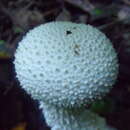en
names in breadcrumbs


Amanita chlorinosma,[1] also known as the chlorine lepidella or chlorine Amanita,[2] is a species of Amanita that can be found mainly in North Carolina (Piedmont and Coastal Plain mainly)[3] but can range from Massachusetts and Illinois and south to Florida in pine and oak forest woodlands.[4] Its life cycle is perennial. The strong chlorine or rotting meat odor coming from it makes this easily recognized.
The Amanita chlorinosma is strongly considered to be toxic due to its many poisonous characteristics, although little research has been done on this particular species. This mushroom's poisonous nature is indicated by its large size, powdered cap, enlarged stalk base, and strong chlorine or rotten meat odor. The stem is said to be the most poisonous component. It is expected that it would cause symptoms like other Amanita species if ingested: nausea, vomiting, disorientation, abdominal aches, etc. 30 minutes to several hours after consumption, symptoms start to appear. [3]
The Amanita chlorinosma has a very large cap, up to 10-inch-diameter, that is white and covered in dense, soft, powdery scales that can be easily washed off in the rain. The gills are nearly free with cottony edges. The lower third of the stalk is frequently submerged in soil and is significantly enlarged and whitish. The annulus (ring) is thin, whitish, and frequently left on the border of caps without stalk tissue. The spore print has a strong chlorine or rotten meat smell, especially when broken open or kept in a container for a while. [5] Usually growing in landscapes, natural settings, or forests, it occurs more frequently under oak or pine trees than under pine. [3] [4]
Amanita chlorinosma, also known as the chlorine lepidella or chlorine Amanita, is a species of Amanita that can be found mainly in North Carolina (Piedmont and Coastal Plain mainly) but can range from Massachusetts and Illinois and south to Florida in pine and oak forest woodlands. Its life cycle is perennial. The strong chlorine or rotting meat odor coming from it makes this easily recognized.